This website is supported by its readers. If you click one of my links I may earn a commission. I am also a participant in the Amazon affiliates program and I will also earn a commission from qualified purchases.

Without a doubt, Ficus trees also referred to as Fig trees, are one of the most common indoor and outdoor home plants many of us own. With over 800 different sub-species, it can be easy to find a tree that suits your home. One common problem, however, that these trees can have is their roots. So do Ficus trees have invasive roots?
Ficus trees planted outdoors have incredibly invasive roots, regardless of sub-species. The tree’s roots will typically expand to three times the tree’s canopy. Ficus tree roots can quickly impact drains, paving, sidewalks, fences, and neighboring trees and plants.
So what species of Ficus tree have the most invasive roots? And how do you prevent your Ficus tree roots from becoming invasive? Keep reading to find out more!
Just a quick heads up, over the past three years of running Plantpaladin, hundreds of people have asked for product recommendations. As such, You can find my favorite indoor bonsai tree here (link takes you to Bonsaiboy), my favorite outdoor bonsai tree (link takes you to Bonsaiboy), or have a look at all the products I recommend here.
Do Ficus trees have invasive roots?
So, having some success growing Ginseng Ficus bonsai, I decided to branch out (no pun intended) into the wider Ficus/Fig-tree species.
Having moved home recently, I want to add my stamp both indoors and outdoors and add a few new Ficus trees to my home.
However, one problem adult Ficus trees have when compared to Ficus bonsai trees is invasive roots.
I wanted to ensure I did my homework before investing in any new Fig trees.
I got in touch with a few tree experts, went on a quick trip to my local botanical gardens, and even undertook a survey of 20 plant paladin readers who own Ficus.
All to ask them do Ficus trees have invasive roots.
- Almost all Ficus tree species have invasive roots.
- These roots typically grow relatively fast, adding around 5 meters (16 feet) of growth yearly until they mature.
- When fully grown, the growth rate of roots in Ficus trees will typically drop to about 1 meter per year (3 feet).
- The deepest Ficus roots can grow to about 3 feet, with most Ficus trees growing only 1- 3 feet deep.
- Most of the problem with Ficus roots comes with how far these roots can spread laterally.
- Ficus tree’s roots then will typically expand to about 50 feet wide (15 meters) in non-permeable soil and around 20 feet (6 meters) in porous soil.
- The exact growth rate will vary from species to species.
- In the right conditions, ficus trees will typically spread their roots to about three times the size of the widest point of your Fig trees canopy.
- While all Ficus trees have invasive roots, Florida Strangler Fig, Brown Turkey, Ficus Nitida, and Moreton Bay Figs are particularly fast growing.
- While keeping a Ficus tree in a pot will limit its root growth, ensure you repot every one to two years to prevent damaging your tree.
- Ficus tree roots will be at their most invasive during the spring and summer growing seasons.
Now, this is quite a lot of information to take in, so let’s break down these points in more detail below:
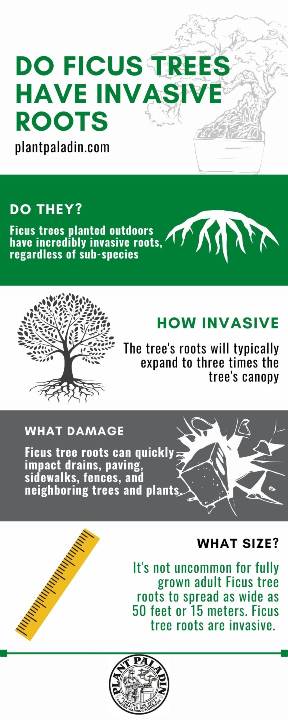
How deep do Ficus tree roots grow?
Most Ficus tree roots grow 1 foot deep. The typical range of depth for Ficus tree roots is 1 to 3 feet deep. Ficus tree roots are incredibly invasive and can grow up to 50 feet ( 20 meters) wide.
How wide do Ficus tree roots grow?
Ficus tree roots, regardless of sub-species, typically grow three times as wide as the tree’s canopy at its widest point. It’s not uncommon for fully grown adult Ficus tree roots to spread as wide as 50 feet or 15 meters. Ficus tree roots are invasive.
What season are Ficus tree roots the most invasive?
So now you know that Ficus trees have invasive roots. Is there anything you can do to manage these roots throughout the year? (aside from buying a fake Ficus tree, that is)
After all, trees don’t necessarily grow at an even pace throughout the year.
So when exactly do Ficus tree roots grow the fastest and become the most invasive?
To summarize, I’ve made a table below:
Season | Growth rate |
Spring | 2 to 3 meters if immature, 50cm if mature |
Summer | 1 to 2 meters if immature, 30cm if mature |
Fall | 0.5 meters if immature, 20 cm if mature |
Winter | Low growth |
The exact root growth rate/invasiveness will vary from species to species. this is a good rule of thumbs
Spring
Ficus tree roots will be the most invasive during the spring. These roots can grow as much as 2 to 3 meters when maturing during the seasons. If the Ficus is mature, you can expect around 50cm of growth between March and May.
Summer
Ficus trees love bright, sunny, and, most importantly, hot conditions.
As such, the roots can still grow significantly when other tree species might slow their growth a little
It’s not uncommon for Ficus tree roots to grow as prominent in the summer as they do in the spring.
With most of us living in milder conditions, however, it is more accurate these trees will grow around 1 to 2 meters if immature and around 30cm if mature.
Fall
During the fall, a Ficus tree’s growth rate will slow as it prepares to store its energy for the winter months.
The same goes for the roots of Fig trees, which will grow significantly less than in the previous two seasons.
Expect a root growth rate of around 20cm to 50cm, depending on the age of the Ficus.
Winter
Ficus tree roots will grow very slowly, if at all, during the winter.
The trees will try to store as much energy as possible during winter.
Some species, however, may show some signs of root growth during the winter and can average between 5 to 10cm of new root growth.
Does heat impact invasive Ficus roots?
Ficus trees are tropical trees and thrive in bright sun and warm conditions.
While most of us keep these trees indoors, if you live in ideal conditions for them, such as in Florida, which has year-round sun, Ficus trees will grow at their fastest rates.
The roots of a Ficus will be significantly more invasive in these warmer conditions than in more temperate, mild climates such as the UK.
As a general rule of thumb then, the warmer and hotter the climate, the more invasive the roots of a Ficus tree will be.
Ficus trees grow between 60 Degrees F and 100 degrees F, so if you live in a climate with those temperatures year round, take note that your Ficus tree may produce invasive roots.
How fast do Ficus tree roots grow?
Ficus tree roots will expand at a rate of 5 meters per year in the tree’s first 10 to 15 years. Once the tree is mature, this growth rate will reduce to around 1 meter per year. The roots will grow faster during the spring and summer.
Ficus tree roots can reach as wide as 50 feet.
The roots, however, do not typically grow that deep, growing only 1 to 3 feet deep and adding about 5 to 10cm of downward root growth per year.
It is very much a case of Ficus roots being invasive laterally rather than causing deep damage.
However, the exact growth speed of a Ficus tree will vary from species to species.
Ficus trees, in general, can be incredibly fast-growing if grown in the right conditions.

How to prevent invasive roots in a Ficus?
So now we know that Ficus treed have invasive roots; what are some quick tips you can implement today to either work with the invasive roots or not make the roots so invasive?
Let’s explore these in more detail:
Plant your Ficus tree in a pot
Now, for the vast majority of you, noticing Ficus tree have invasive roots might be something you might not have witnessed.
The main reason for this is most people who live in cooler climates keep their Ficus trees in pots indoors.
Your roots will never grow out to be as invasive in pots as they would do if planted in the ground outdoors.
An easy step to prevent your outdoor Ficus trees from having invasive roots would be to place them in a pot.
Placing in a pot works incredibly well if your Ficus tree is 1.5 meters tall or less, making it a lot more manageable to move.
I’ve written a post if you are interested in learning how to repot your Ficus tree.
To summarize
Use a root hook to pry your Ficus tree from the ground.

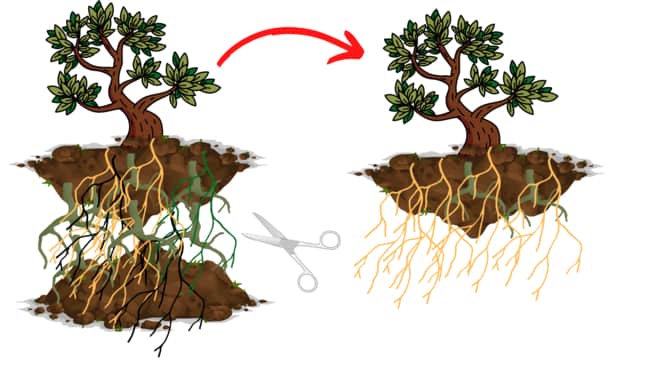
Add a good potting soil mix to a pot with several drainage holes. Wire your pot through the drainage holes to prevent your Ficus tree from moving.

Place your Ficus tree in your pot, and use copper wire to hold it in place.
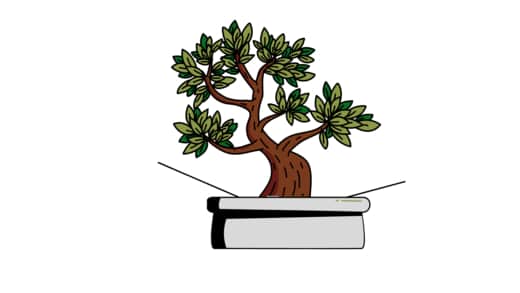
Fill with topsoil and maintain good aftercare.
Now while placing a Ficus tree in a pot will significantly reduce the invasiveness of its roots, you still need to repot the tree once every one to two years.
Repotting will prevent the Ficus tree roots from getting crushed in the pot, which can lead to health problems for your Ficus tree.
Move your Ficus indoors
So if you have managed to move your Ficus tree from being planted into the ground to a pot but still notice excessive root growth, then consider moving your Ficus tree indoors.
As mentioned, Ficus trees in more temperate climates are usually kept indoors due to the cooler temperatures outdoors.
Excessive roots will typically grow in hotter brighter conditions, so moving your Ficus tree indoors will limit the sunlight reducing the growth rate of said roots.
Create a trench
So, while the above two methods are fantastic for dealing with Ficus trees that are smaller in size, if you have an older Ficus tree, then I do not doubt that these trees will be significantly larger.
In these situations, repotting is not a viable option.
As such, we need to do what we can to limit the existing roots in the ground.
One of the best methods to do this would be to create a trench around the perimeter of your Ficus tree roots to create a root barrier to prevent surrounding destruction.
To do this, dig a trench that is about 1 foot deep near the perimeter of items that the roots can end up disturbing.
Typical items it can damage include fences, pavements or sidewalks, swimming pools, nearby gutters, or even brickwork such as walls.
Aim for this trench to be expansive, around 12 feet long, and around the perimeter of the items, you want to protect.
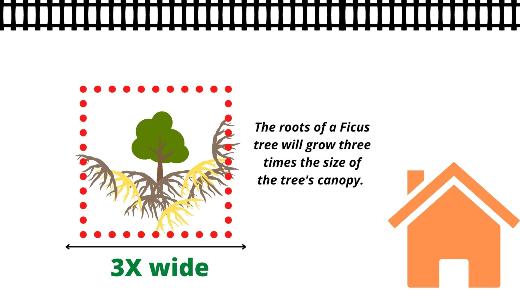
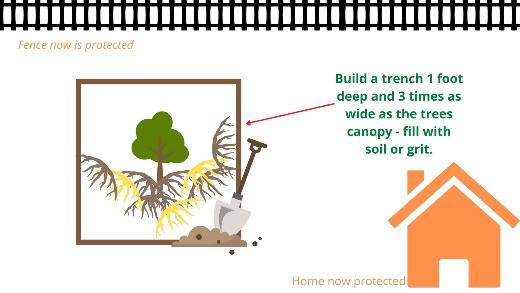
You will also want to ensure that the trench is futureproofed, so build the trench at least 6 feet away from the tree canopy.
As mentioned earlier, Ficus tree roots can grow three times the size of the canopy so keep that in mind.
Once the trench is built, you will then need to fill this up with material to reinforce the trench.
Potting soil typically works best, but I prefer to use inorganic soil mixes filled with wood chips, grit, or stones to make the trench as dense as possible.
Cut the roots
Now, while the trench method is incredibly effective at preventing excessive root growth, it too is not a viable solution for everyone.
After all, digging a 12-foot barrier around the Ficus means you need a pretty large backyard.
So what do you do if you have limited garden space?
Simply put, trim back the roots.
One of the advantages of Ficus tree roots, when compared with, say, oak tree roots, is that they tend to be closer to the ground than deep inside.
Trimming the roots back can prevent excessive invasive roots from spreading outwards.
How many roots should you cut?
Aim to cut only 30% of the visible roots from your Ficus tree. Removing too many roots will kill your tree.
How close to the tree should you remove the roots?
The closer you remove the roots from the tree, the more damage it will cause to the tree.
As such, you will need to find the balance of trimming the roots far away from your tree so it won’t cause damage but close enough that you stop the roots from becoming invasive.
Aim then to trim the roots until they are about double the size of the canopy of your trees.
For example, if the canopy of your trees at its widest point is 10 meters, its root structure will be 30 meters ( Ficus tree roots can grow as large as three times the size of the tree’s canopy). Aim to trim these roots back to 20 meters.
However, you will need trial and error to find the perfect balance, which is why I recommend starting at double the size of the canopy of your trees and then gradually removing the distance over time.
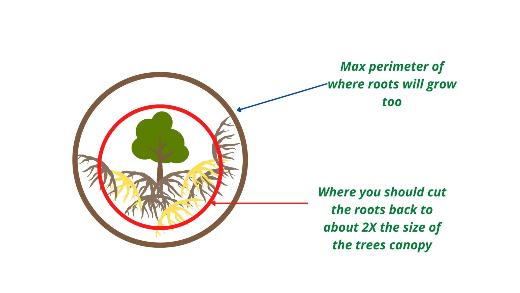
For example, in your first year, you might stick to double the trees canopy. In your second year, you might aim for 1.75 the tree canopy size.
How often should you trim the roots of invasive Ficus trees?
Invasive Ficus tree roots should only be trimmed once per year during the spring/summer growing season. Trimming during the spring/summer will give your Ficus tree enough time to recover from the invasive produce during the summer months.
How to trim invasive Ficus tree roots?
Set a perimeter around the tree to trim invasive Ficus tree roots.
Aim for this to be twice the size of the tree’s canopy.
This will create a border between the roots you will remove and the roots you cannot see.
Mark this with either string or masking tape.
Then, dig up the roots from outside the perimeter using a shovel or trowel.
These roots will be further away from the tree, so they should be easier to remove.
Aim to dig about 1 foot deep, which is as deep as these roots can burrow.
Then using either loppers or root cutters, aim to make a sharp cut at the perimeter of these roots.
Repeat until the roots from the perimeter are removed.
However, this method will only really work if the Ficus tree is still relatively young, around two years or less.
This is because old Ficus tree roots are almost near impossible to move due to their strength, and new Ficus trees sprout from the older roots.
Kill the tree
Finally, the most powerful method of preventing your Ficus tree from having invasive roots is to kill the tree.
To do so, trim the tree with a chainsaw until you are left with a stump.
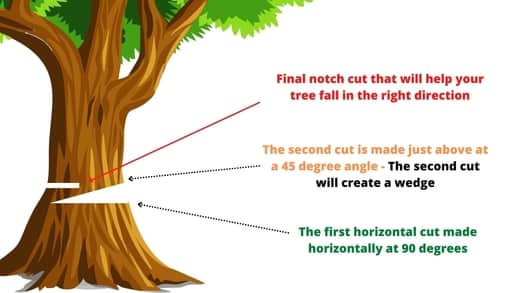
Then drill several holes in the stump and apply a herbicide, saltwater, or copper nail into the stump.


Cover with a blag bag, and after a few weeks, try to dig up.
The black bag will prevent sunlight or water from going near the tree.
Now while this is effective at killing the stump., Ficus trees are survival specialists, and many new Ficus tree seedlings may sprout from the existing root structure.
I recommend covering the existing root structure with a tarp to prevent sunlight and kill back roots before digging them up.
Once again, this method will only work for Ficus trees about a year or two old.
Older Ficus trees will have significantly thicker roots, making it almost impossible to lift them.
Are Ficus tree roots easy to dig up?
Ficus tree roots are not easy to dig up. The older a Ficus tree, the stronger and more difficult it becomes to remove the roots. Ficus roots can only be trimmed back or dug up in the first one to three years while the roots are still growing.
These roots are so tough, in fact that the California Invasive Plant Council has suggested:
“Efficient control method for edible Fig has not yet been developed.”
Why you need to deal with invasive Ficus roots
Invasive Ficus roots must be dealt with to prevent damage to surrounding items. Drainpipes, pavements and sidewalks, guttering, pools, and other plants and trees are all easily dug up by invasive Ficus roots, causing thousands of dollars worth of damage.
Do indoor Ficus trees have invasive roots too?
Ficus trees kept indoors do not have anywhere near as invasive a root structure as Ficus trees are grown outdoors in the ground. These trees’ pots are kept indoors to prevent the roots from expanding outwards, stunting their growth.
Ensure you repot an indoor Ficus tree once every one or two years.
Will Ficus roots grow back?
Ficus tree roots will grow back over time, regardless of if you have trimmed them back.
The root structure is so expansive on Ficus trees that they will likely still be attached to the tree’s stump. The stump of the Ficus tree can also push new seedlings or suckers through and restart new growth.
The only accurate way then to kill Ficus tree roots is to remove and kill the tree altogether.
If, however, you want to keep your Ficus tree, and your tree is older, know that it will be a yearly endeavor to try and trim it back.
What species have the most invasive roots?
All species of Ficus tree have invasive roots if planted outdoors.
That being said, some specific Ficus grow faster than others.
The following end to be the worst when it comes to invasive roots:
- Florida Strangler Fig
- Indian Banyan
- Brown Turkey
- Moreton Bay Figs
- Fiddle Leaf Figs
- Ficus Benjamina
On the other hand, Ficus trees used for bonsai, such as Ginseng Ficus tend to have the least invasive root growth.
How close to the house should you plant a Ficus Tree?
You should plant Ficus trees about 50 feet away from your home. This is because the root structure can be incredibly invasive, expanding three times the size of the tree’s canopy. To prevent extensive damage, ensure your tree does not grow too large.
For example, let’s say you want to plant a Ficus tree in your backyard.
I would recommend not growing this tree to more than 2 meters tall.
This will ensure that the tree’s root structure grows no bigger than around 6 meters wide.
You can then plant or pave items 6 meters away from the tree.
Do Ficus trees damage foundations
If Ficus trees are planted close enough to your home, they can damage the foundations. This is especially true in older, taller Ficus trees. The roots of these trees can be complicated to trim once they reach maturity.
When planting a Ficus tree, ensure that you do so either in a pot or as far away from surrounding items.
Does Ficus Benjamina have invasive roots?
Ficus Benjamina is incredibly invasive and one of the most invasive species of Ficus available. These trees can kick up driveways, sidewalks, piping, drainage, fences, swimming pools, and most items they come into contact with.
To prevent excess roots, plant in a pot or keep the tree short and away from items it can easily damage.
Do Ficus bonsai have invasive roots?
Due to the miniaturization process, Ficus trees commonly used in bonsai, such as Ginseng Ficus, do not have invasive roots. This is so long as the tree is kept relatively small in size and grown in a bonsai pot instead of planted outdoors in the ground.
Survey on do Ficus trees have invasive roots?
Finally, I wanted to finish up by doing a quick survey of 20 plant paladin readers who own Ficus trees and asked them directly if Ficus trees have invasive roots.
To summarize:
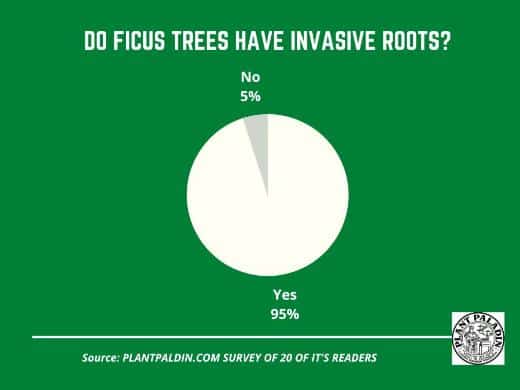
Many of you are in the process of growing/caring for Ficus trees; hopefully, the table below can help give a quick care guide:
I’d also recommend having a look at the following if you are running into problems with your Ficus:
How to care for a Ficus
Ginseng Ficus Bonsai tree Requirements | Explained |
Water | Once per day in the spring-summer or if kept indoors. Once per week if kept outdoors during the winter. Only water if dry to touch. |
Sunlight | 4 hours of direct sunlight in the summer. LED grow light can also be used. |
Temperature | Between 60 degrees F and 100 degrees F |
Fertilizer | Fertilize 18 times per year, twice per month between spring and summer. Once per month in the fall and winter |
Repotting | Once every 2 to 3 years in the first 10 years. You can then report once every 5 years |
Placement | Can be placed outdoors in direct sunlight or indoors in a bright spot. |
Wire type | Both copper and aluminum wire can be used. |
Time to grow from scratch into maturity | 8 to 12 years to reach full maturity |
Potting soil | An inorganic Akdama, volcanic ash soil mix works best. |
Growth type | Slow growing, averaging 3-5 inches per year |
Size | Average store-bought trees are size is one or two-handed bonsai trees - 3 to 10 inches in size, 2 to 8 inches wide |
Lifespan | 50 to 150 years |
Fruit | figs |
- How to straighten a Ficus tree
- Do Ficus trees like coffee grounds?
- How long do Ficus trees live?
- Are Ficus trees toxic to cats
- Why are my Ficus leaves turning yellow
- Do Ficus trees have berries
- Do Ficus produce seeds
My top picks for the gear you will need!
So like I mentioned earlier, over the past three years of running PlantPaladin, hundreds of people have asked me for my recommendations on the best bonsai gear on the market.
Having spent thousands of dollars on bonsai items these past few years and tested at least 100 bonsai-specific products, I’ve listed my favorite products below – All of which I highly recommend and think you can get great value.
They can purchase directly by clicking the link to take them to Amazon.
Bonsai Tool Set: One of the significant challenges I’ve had is finding a toolset that was not only durable but didn’t break the bank. SOLIGT has recently developed a fantastic bonsai tool set that covers all the tools you need to trim, prune, and repot your trees. – You can grab it here.
Complete Bonsai Set: Many of you will want to grow your bonsai trees entirely from scratch, but finding the varicose seeds, pots, and other items in one place can be challenging. Leaves and Sole then have created a complete bonsai set that I’ve personally used that ticks all the boxes. You can grab it here.
Bonsai wire: The number of times I’ve run out of wire for my bonsai or purchased cheap bonsai wire that doesn’t do the job is embarrassing for me to admit. After a lot of trial and error, I found that using Hotop’s aluminum bonsai wire is one of the best options on the market. This can easily be used for both indoor and outdoor bonsai. You can grab it here.
This post was written by Fehed Nicass who has been passionate about bonsai for over 3 years. He currently resides in the UK and works in sales.
